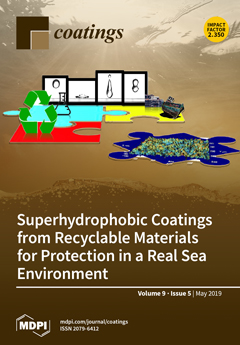The effects of doping a p-type CuCrO
2 film with zinc on its structural and optoelectronic properties were investigated by experiments using CuCr
1−xZn
xO
2 thin films (
x = 0, 0.025, 0.065, 0.085). An increase in the amount
[...] Read more.
The effects of doping a p-type CuCrO
2 film with zinc on its structural and optoelectronic properties were investigated by experiments using CuCr
1−xZn
xO
2 thin films (
x = 0, 0.025, 0.065, 0.085). An increase in the amount of zinc dopant in the thin films affected the lattice constant and increased its Gibbs free energy of phase transformation. Cross-sectional images of the CuCrO
2 thin film samples exhibited a dense polygonal microstructure and a surface morphology with protruding nanoscale granules. With the increase in the amount of Zn dopant, the surface roughness decreased, thereby increasing the amount of incident photons as well as the visible-light transmittance and ultraviolet-light absorption of the thin films. With the zinc doping in the CuCrO
2 thin films, the band gap increased from 3.09 to 3.11 eV. The substitution of Cr
3+ with Zn
2+ forms hole carriers in the crystals, which was demonstrated by X-ray photoelectron spectroscopy and Hall effect measurements. The conductivities and carrier concentrations of the Zn-doped CuCrO
2 thin films were greater than those of undoped CuCrO
2. The CuCr
1−xZn
xO
2 film (
x = 0.065) exhibited the best optoelectronic properties; its carrier concentration and resistivity were 1.88 × 10
17 cm
−3 and 3.82 Ωcm, respectively.
Full article





